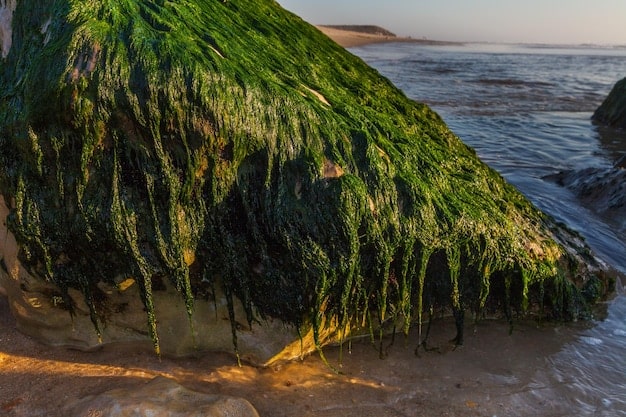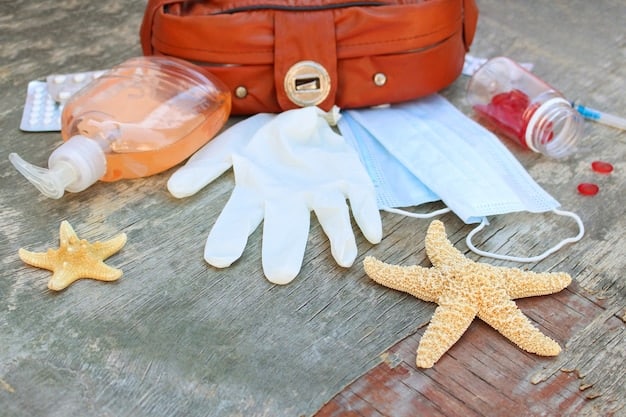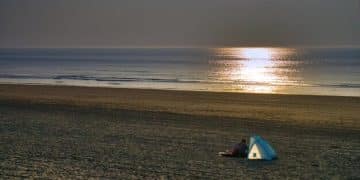Beach Hazards: Jellyfish, Seaweed, & Sharp Objects Guide

Navigating the complexities of beach environments requires an understanding of common hazards like jellyfish, seaweed, and sharp objects to ensure a safe and enjoyable experience for all visitors.
Venturing to the beach promises relaxation and fun, but it also comes with potential risks. Understanding and preparing for common dangers such as identifying common beach hazards: jellyfish, seaweed, and sharp objects is crucial for a safe and enjoyable coastal experience.
Understanding the Diverse Threats of Jellyfish
Jellyfish are mesmerizing creatures, often admired for their graceful movement and translucent bodies. However, their beauty belies a potent defense mechanism: stinging tentacles. These can deliver painful stings, ranging from mild irritation to severe neurological effects, depending on the species and an individual’s sensitivity. Knowing what to look for and how to react is paramount for beachgoers.
Different species of jellyfish present varying degrees of danger. For instance, the Portuguese Man O’ War, though technically a siphonophore, is frequently mistaken for a jellyfish due to its appearance and delivers an incredibly painful sting. Its gas-filled float makes it easily identifiable, often washing ashore after storms. Similarly, the Box Jellyfish, particularly prevalent in warmer waters, is infamous for its potentially fatal venom, making identification and avoidance critical.
Common Jellyfish Species and Their Impact
Identifying common species is the first step toward prevention. The Moon Jellyfish, for example, is often seen in coastal waters and has a relatively mild sting, causing only minor discomfort. In contrast, the Lion’s Mane Jellyfish, one of the largest species, can produce a significant sting due to its numerous long tentacles. Awareness of regional jellyfish populations is vital for any beach trip.
- Moon Jellyfish: Transparent, saucer-shaped bell with four distinct horseshoe-shaped gonads; mild sting.
- Lion’s Mane Jellyfish: Large, reddish-brown bell with long, thin tentacles; painful sting.
- Portuguese Man O’ War: Blue/purple, gas-filled float with long, trailing tentacles; extremely painful and dangerous sting.
- Box Jellyfish: Cube-shaped bell, complex eyes, and highly venomous; potentially lethal sting.
Environmental factors play a significant role in jellyfish presence. Warm ocean currents, specific tidal patterns, and prevailing winds can bring large numbers of jellyfish closer to shore. Local lifeguards and beach advisories are excellent sources of real-time information regarding jellyfish activity. Heeding these warnings can prevent painful encounters.
Should a sting occur, immediate action is crucial. While folk remedies abound, scientific consensus suggests rinsing with vinegar for most species (excluding Portuguese Man O’ War, for which saltwater rinse is recommended), removing any remaining tentacles with tweezers, and applying heat. This can help denature the venom and alleviate pain. Seek medical attention for severe reactions or stings from highly venomous species.
Navigating the Challenges Posed by Seaweed
Seaweed, an umbrella term for various marine algae, is a natural and essential part of the marine ecosystem. It provides food and habitat for countless organisms and plays a crucial role in oxygen production. However, for beachgoers, large accumulations of seaweed can present distinct challenges, ranging from aesthetic nuisances to potential health concerns and physical hazards.

One of the most common issues with excessive seaweed is its impact on beach aesthetics. Large mats of rotting seaweed can emit unpleasant odors as they decompose, releasing hydrogen sulfide gas. This can detract significantly from the sensory experience of a beach visit, making it less appealing for recreational activities. Beyond the smell, the visual aspect of a beach covered in seaweed can be off-putting to tourists and locals alike.
Types of Seaweed and Their Beach Presence
Different types of seaweed manifest differently on beaches. Sargassum, for example, is a brown algae known for forming vast floating mats in the Atlantic Ocean, often washing ashore in massive quantities, particularly in the Gulf of Mexico and Caribbean. Its dense, tangled structure can impede swimming and create tripping hazards. Green algae, like sea lettuce, can also accumulate, forming slimy, slippery surfaces near the water’s edge.
- Sargassum: Brown, branching algae, often with small, berry-like air bladders; forms large floating mats.
- Ulva (Sea Lettuce): Bright green, thin, broad blades; can form slippery mats on the shore.
- Kelp: Large, brown algae often found attached to rocky substrates; can be washed ashore after storms in long, rope-like strands.
The accumulation of seaweed can also create more direct physical hazards. Wet seaweed is incredibly slippery, increasing the risk of falls and injuries, especially near the waterline or on rocky areas. When dried, it can become brittle and coarse, making walking uncomfortable. Moreover, decaying seaweed can attract various insects, including sand flies and other biting pests, adding another layer of discomfort for beach visitors.
While often benign, excessive seaweed can sometimes pose minor health concerns. As it decomposes, bacteria thrive in the warm, moist environment. While most are harmless, prolonged exposure or contact with open wounds could potentially lead to minor skin irritations or infections. It’s always wise to rinse off thoroughly after walking through heavy seaweed deposits, especially if you have sensitive skin or existing cuts.
Local authorities often implement strategies to manage seaweed, ranging from manual removal to advanced environmental monitoring. However, complete eradication is usually undesirable due to seaweed’s ecological importance. Beachgoers can contribute by being mindful of their steps and reporting unusually large or problematic accumulations to beach staff or lifeguards, helping maintain a balance between ecological health and recreational enjoyment.
The Ubiquitous Threat of Sharp Objects
The seemingly pristine sand of a beach can often conceal a variety of sharp objects, posing a significant risk to unsuspecting feet. From natural debris to human-made litter, these hidden hazards can quickly turn a relaxing stroll into a painful emergency. Awareness, vigilance, and appropriate footwear are key to mitigating this pervasive danger on any coastline.
Natural sharp objects are an inherent part of the beach environment. Broken shells, particularly larger pieces with jagged edges, are common culprits. These can easily penetrate bare skin, leading to cuts and punctures. Sharp, fragmented pieces of coral, especially in areas with coral reefs, also present a considerable risk, as do sharp, broken branches or driftwood splintered by the tides.
Identifying Common Sharp Objects
Distinguishing between harmless and hazardous objects is often difficult due to shifting sands and murky water. However, understanding the types of sharp items commonly found can help. Human-made debris is particularly concerning due to its widespread presence and varied forms. Glass shards from broken bottles are notoriously dangerous, often blending seamlessly with wet sand. Metal objects, such as discarded cans, fishing hooks, or even rusty nails, pose risks of cuts and tetanus.
- Broken Glass: Fragments of bottles or other glassware, often clear or tinted, blending with sand.
- Metal Scraps: Rusty nails, sharp can edges, discarded fishing hooks, or other industrial debris.
- Broken Shells/Coral: Jagged edges of natural marine structures, deceptively sharp.
- Wood Splinters: Sharp points from driftwood, boardwalks, or broken picnic tables.
The impact of stepping on a sharp object can range from a minor cut requiring a simple bandage to a deep puncture wound necessitating medical attention. Puncture wounds are particularly concerning as they can introduce bacteria deep into the tissue, leading to infections. Tetanus is a serious risk from rusty metal objects, making up-to-date vaccinations important for any beach regular.
Prevention is largely about vigilance and choosing appropriate footwear. Walking barefoot on a beach, while tempting, significantly increases the risk of injury from sharp objects. Water shoes or sturdy sandals with thick soles offer a good layer of protection, particularly when entering or exiting the water where visibility is often limited. Avoiding walking in areas known for significant debris accumulation, such as near dumpsters, under piers, or close to stormwater outflows, is also advisable.
When an injury occurs, immediate first aid is essential. For minor cuts, clean the wound with soap and water, apply antiseptic, and cover with a sterile bandage. For deeper wounds or those that continue to bleed, apply pressure and seek immediate medical attention. Always notify beach authorities or lifeguards of dangerous debris to prevent others from being injured, contributing to a safer environment for everyone.
Essential Preparedness: Before You Go to the Beach
A successful and safe beach trip begins long before you set foot on the sand. Proper planning and preparation are crucial steps in mitigating risks from common beach hazards. By taking a few proactive measures, you can significantly enhance your safety and enjoyment, ensuring your time by the ocean is memorable for all the right reasons, not for an unexpected injury or discomfort.

Before heading out, a quick check of local conditions and advisories is paramount. Many coastal areas have online resources, dedicated apps, or provide real-time updates through local news channels regarding beach conditions. These advisories can include warnings about strong currents, presence of dangerous marine life like jellyfish, or even water quality issues. Lifeguard stands often display flags indicating water safety levels, and familiarizing yourself with these universal signals can save you from potential danger.
Beach Safety Checklist
Packing appropriate gear is another critical element of preparedness. Sunscreen is non-negotiable for protecting your skin from harmful UV rays. A wide-brimmed hat and UV-protective clothing offer additional defense. Hydration is also vital, so bringing plenty of water is essential, especially on hot days. Beyond personal comfort, specific items can directly address hazards.
- First-aid Kit: Essential for minor cuts, scrapes, and stings. Include antiseptic wipes, bandages, pain relievers, and any personal medications.
- Protective Footwear: Water shoes or sturdy sandals can prevent injuries from sharp objects on the sand or in shallow water.
- Vinegar Packet: For treating most jellyfish stings, as advised by medical professionals (consult local guidelines).
- Appropriate Swimwear: Rash guards or full-body suits can offer a physical barrier against minor stings and sun exposure.
Familiarizing yourself with the specific beach environment you plan to visit can also be highly beneficial. Researching whether the beach is known for rocky areas, strong tides, or particular marine life can help you anticipate potential hazards. Some beaches are more prone to seaweed accumulation due to their geography or prevailing currents, while others might be seasonal hotspots for certain jellyfish species. Equipped with this knowledge, you can make informed decisions about where to set up camp and where to avoid.
Finally, a critical aspect of preparedness involves knowing basic first aid and emergency procedures. Understanding how to treat a minor cut, a jellyfish sting, or recognizing the signs of heatstroke can be life-saving. Knowing the location of the nearest lifeguard station, emergency call numbers, and how to effectively communicate a problem are all integral parts of being a responsible and prepared beachgoer. Taking these steps ensures that your beach visit remains a safe and enjoyable experience for everyone involved.
Immediate Actions: What to Do If You Encounter a Hazard
Despite thorough preparation, encounters with beach hazards can still occur. Knowing how to react swiftly and effectively in such situations can significantly minimize harm and distress. Immediate action, coupled with calm decision-making, is crucial whether you’ve stepped on something sharp, encountered a jellyfish, or are struggling with dense seaweed. Prioritizing safety and seeking appropriate help are the cornerstones of effective response.
If you step on a sharp object, the first priority is to carefully remove yourself from the water and assess the injury. Avoid putting weight on the injured foot. If the object (e.g., a piece of glass or shell) is still embedded, do not try to remove it unless it’s small and superficial. Gently clean the wound with fresh water (if available) and apply pressure to stop any bleeding. For deep or continuously bleeding wounds, or if you suspect something is still inside, seek immediate medical attention.
Responding to Specific Hazards
Jellyfish stings require a specific approach. Different species may react differently to treatments, so local guidance is key. Generally, avoid rubbing the area, as this can release more venom. Rinse the affected area with seawater (not fresh water) to remove any remaining tentacles. For most jellyfish stings, applying vinegar can help neutralize the venom. However, for Portuguese Man O’ War stings, fresh water or vinegar can worsen the sting; instead, use saltwater and cold packs. Always remove tentacles using tweezers or a gloved hand, never bare fingers. If pain is severe, a rash develops, or breathing difficulties occur, seek urgent medical help.
- Jellyfish Sting: Rinse with seawater (or vinegar for most species), remove tentacles, apply heat/cold pack. Seek medical help for severe reactions.
- Sharp Object Injury: Remove from water, clean wound, apply pressure to stop bleeding. Seek medical attention for deep wounds or embedded objects.
- Dense Seaweed: Avoid struggling, stay calm, slowly work your way out. If tangled, try to untangle limbs calmly; signal for help if necessary.
Encountering dense seaweed, particularly in water, might not seem life-threatening but can be disorienting and exhausting. If you find yourself tangled, remain calm to conserve energy. Do not fight against the seaweed; instead, try to slowly untangle yourself, using sweeping motions with your arms and legs. If you are struggling, float on your back and signal for help by waving one arm. It’s often safer to swim parallel to the shore until you find a clearer patch of water rather than pushing directly through dense seaweed.
In all hazard encounters, communication is vital. Alert lifeguards or beach staff immediately. They are trained professionals equipped to handle emergencies and provide appropriate first aid, or direct you to the nearest medical facility. Providing clear, concise information about the incident allows them to respond effectively and efficiently. Remember, a quick and informed response can turn a potentially serious situation into a manageable one, ensuring the safety of yourself and others.
Protecting Yourself: Practical Tips for Beach Safety
Ensuring your safety at the beach goes beyond simply knowing about hazards; it involves adopting practical habits and making informed choices. A proactive approach to beach enjoyment can drastically reduce the likelihood of encountering painful and potentially dangerous situations. By incorporating a few simple yet effective safety tips into your beach routine, you can maximize your fun while minimizing risks.
One of the most fundamental safety practices is never swimming alone. Having a buddy ensures that if one of you encounters an issue, the other can provide immediate assistance or call for help. This is particularly important for children, who should always be supervised closely by an adult, even in shallow water. Designate a meeting spot if you separate, especially on crowded beaches, to prevent becoming disoriented or lost.
Key Safety Practices at the Beach
Always swim at beaches with lifeguards on duty. Lifeguards are trained water safety professionals who can identify and respond to various hazards, from rip currents to marine life encounters. Their presence provides an invaluable layer of protection, as they can quickly administer first aid, initiate rescues, and inform beachgoers about real-time conditions. Heeding their advice and directives is paramount for your safety.
- Swim Near Lifeguards: Always choose beaches with active lifeguard patrols and stay within their designated swimming areas.
- Use the Buddy System: Never swim or venture far from shore alone; always have a companion.
- Wear Sun Protection: Apply broad-spectrum sunscreen regularly, wear hats, and consider UV-protective clothing.
- Stay Hydrated: Drink plenty of water to prevent heatstroke and dehydration, especially on hot, sunny days.
- Educate Children: Teach children about beach safety, including “look, don’t touch” for marine life, and the importance of staying close.
Being attentive to your surroundings is another critical aspect of beach safety. Walk with your eyes scanning the sand ahead of you, particularly in areas with debris. When entering the water, shuffle your feet to stir up the sand and alert any buried marine life, like stingrays, giving them a chance to move away. This “stingray shuffle” can prevent painful encounters. Avoid murky water where visibility is poor and hazards might be hidden.
Respect local wildlife and their habitats. While it might be tempting to interact with marine creatures, maintaining a respectful distance is crucial for both your safety and their well-being. Never touch or provoke marine animals, especially those that appear distressed or unusual. Observing from a distance is the safest approach. Similarly, avoid disturbing sensitive ecological areas like dunes or nesting sites, as they can also harbor unseen dangers.
Finally, always remember to clean up after yourself. Discarding litter properly in designated bins prevents it from becoming a hazard for others or harming marine life. Taking personal responsibility for your waste is a simple yet impactful way to contribute to the safety and cleanliness of beaches for everyone. By embracing these practical tips, you ensure a safer, more enjoyable, and environmentally conscious beach experience.
Reporting and Community Actions for Safer Beaches
Creating and maintaining safe beach environments requires a collective effort, extending beyond individual preparedness to active community involvement and responsible reporting. When beachgoers take the initiative to report hazards and engage with local conservation efforts, they contribute significantly to the well-being of others and the preservation of coastal ecosystems. This collaborative approach is vital for long-term safety and sustainability.
The first and most immediate action after encountering a significant hazard is to report it to the appropriate authorities. This typically includes lifeguards, beach patrol, or local park rangers. Providing clear and concise information about the type of hazard (e.g., large jellyfish swarm, extensive broken glass, unusual oil slick), its precise location, and the time observed enables authorities to respond quickly, mitigate the danger, and warn other beach visitors. Swift reporting can prevent further injuries or environmental damage.
Engaging in Beach Clean-Up Initiatives
Beyond reporting, actively participating in beach clean-up initiatives offers a tangible way to reduce hazards, particularly sharp objects and general litter. Many local organizations, environmental groups, and even government agencies regularly organize beach clean-ups. These events not only remove dangerous debris but also raise public awareness about the impact of pollution and promote a sense of shared responsibility for coastal health.
- Join Local Clean-ups: Volunteer with environmental groups or community organizations that host beach clean-up events.
- Report Marine Debris: Note and report large accumulations of litter or debris to beach management or environmental agencies.
- Support Conservation Efforts: Donate to or participate in organizations dedicated to marine conservation and beach preservation.
- Advocate for Safer Practices: Encourage friends and family to practice responsible beach etiquette, including proper waste disposal.
Supporting and understanding local beach management policies also plays a crucial role. Many coastal communities implement measures such as regular beach grooming, signage for caution areas, and educational campaigns about marine life. Familiarizing yourself with these efforts and adhering to local regulations (e.g., no glass bottles on the beach, designated swimming zones) helps reinforce established safety protocols. Your compliance and understanding contribute to the effectiveness of these measures.
Educating others, particularly younger generations, about beach hazards and safety protocols is another powerful community action. By sharing knowledge about identifying jellyfish, the risks of sharp objects, and the importance of staying clear of dense seaweed, you help foster a culture of safety and respect for the marine environment. This intergenerational sharing of information builds a foundation for more responsible and informed beach visits in the future.
Ultimately, a safe beach is a shared responsibility. Through diligent reporting, active participation in clean-up efforts, adherence to local guidelines, and educational outreach, individuals can collectively contribute to drastically reducing common beach hazards. This collaborative commitment ensures that these invaluable natural spaces remain enjoyable and secure for everyone, allowing future generations to experience the beauty of the coast without unnecessary risks.
| Key Hazard | Brief Description & Precaution |
|---|---|
| 🐧 Jellyfish | Stinging marine creatures; check local advisories and carry vinegar for stings (specifics vary by species). |
| 🌴 Seaweed | Slippery or tangled marine algae; creates tripping hazards and unpleasant odors. Walk carefully and stay calm if tangled. |
| 🤲 Sharp Objects | Broken glass, shells, metal; can cause cuts/punctures. Wear water shoes, observe surroundings, and report debris. |
| 🚼 Preparedness | Crucial for safety; pack a first-aid kit, check local conditions, and swim near lifeguards. |
Frequently Asked Questions About Beach Hazards
▼
While definitive identification can be tricky without expertise, generally, avoid jellyfish with long, trailing tentacles or distinct, colorful floats (like the Portuguese Man O’ War’s blue-purple float). Always check local beach advisories or ask lifeguards about prevalent species in the area, as they often provide specific warnings.
▼
Not all seaweed is inherently dangerous, but large accumulations can be. Wet seaweed is notoriously slippery, posing a fall risk. Decomposing seaweed can emit unpleasant odors and attract insects. While it’s a natural part of the ecosystem, extensive piles should be navigated carefully, and areas with heavy buildup avoided for swimming.
▼
Immediately exit the water. If the object remains embedded, do not try to remove it unless it’s superficial. Clean the wound with fresh water and apply pressure to stop bleeding. For deep cuts, continuous bleeding, or if you suspect part of the object remains, seek prompt medical attention and consider a tetanus shot if due.
▼
Yes, water shoes or sturdy sandals with thick soles offer significant protection against sharp objects like broken shells, glass, or small stones. They provide a barrier between your foot and potential hazards on the sand and in shallow water, greatly reducing the risk of cuts and punctures while maintaining comfort.
▼
You can contribute by being vigilant and responsible. Report any significant hazards (like large debris or jellyfish swarms) to lifeguards or beach authorities. Participate in local beach clean-up events, dispose of your trash properly, and educate others about safe beach practices. Collective effort ensures cleaner, safer shores.
Conclusion
Understanding and mitigating common beach hazards such as jellyfish, seaweed, and sharp objects is fundamental to ensuring a safe and enjoyable coastal experience. By adopting proactive measures—from checking local advisories and packing a first-aid kit to wearing protective footwear and knowing how to react to encounters—beachgoers empower themselves to navigate the marine environment responsibly. Each individual’s vigilance, combined with community efforts in reporting hazards and participating in clean-ups, contributes significantly to maintaining the safety and pristine condition of our invaluable beaches for all.





